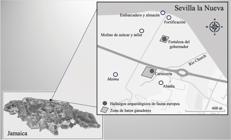Abstract
Shortly after Christopher Columbus discovered the Caribbean islands, he faced a completely unfamiliar reality. According to the logbook entries, everything was different from what had been previously known: contrasting climates, unexplored flora, and species alien to European everyday life. In connection with the colonization of Jamaica, the animals transported beginning in 1493 contributed to the development of a food system initially marked by the need for survival and, later, by everyday life, a situation that would be replicated throughout the Caribbean. Under these circumstances, the founding of villages was crucial, from which the process of adaptation, reproduction, and later exploitation of the fauna on the island of Jamaica began. In some cases, these villages served as points for establishing livestock farms, with the aim of consolidating the foundations for occupation and a self-sufficient economy. Specifically, the objective of this document is to highlight the usefulness and contributions that emerged from the Iberian Peninsula, La Gomera, and Gran Canaria, beginning in October 1493, regarding the animals included in the voyage, which constituted the genesis of the colonization of the Greater Antilles. This research presents an approach that combines the analysis of historical sources with archaeological references, with the aim of identifying live animals and their derivatives that were part of the colonization process on the island of Jamaica. This approach also seeks to locate potential livestock farms that were established, with the goal of identifying the production centers that supported these expansion processes. To this end, understanding the role of fauna and its products in the dynamics of colonization, with an emphasis on their influence on nutrition, ecological adaptation, and the colonial economy, is crucial.
Keywords:
Caribbean; colonization; Jamaica; fauna; consumer derivatives

 Los animales y derivados de consumo introducidos en la isla de Jamaica en el proceso de ocupación hispana, 1493-1536
Los animales y derivados de consumo introducidos en la isla de Jamaica en el proceso de ocupación hispana, 1493-1536 Thumbnail
Thumbnail
 Diseño de imagen: Enrique Gómez Velázquez, 2025. Fuente:
Diseño de imagen: Enrique Gómez Velázquez, 2025. Fuente: